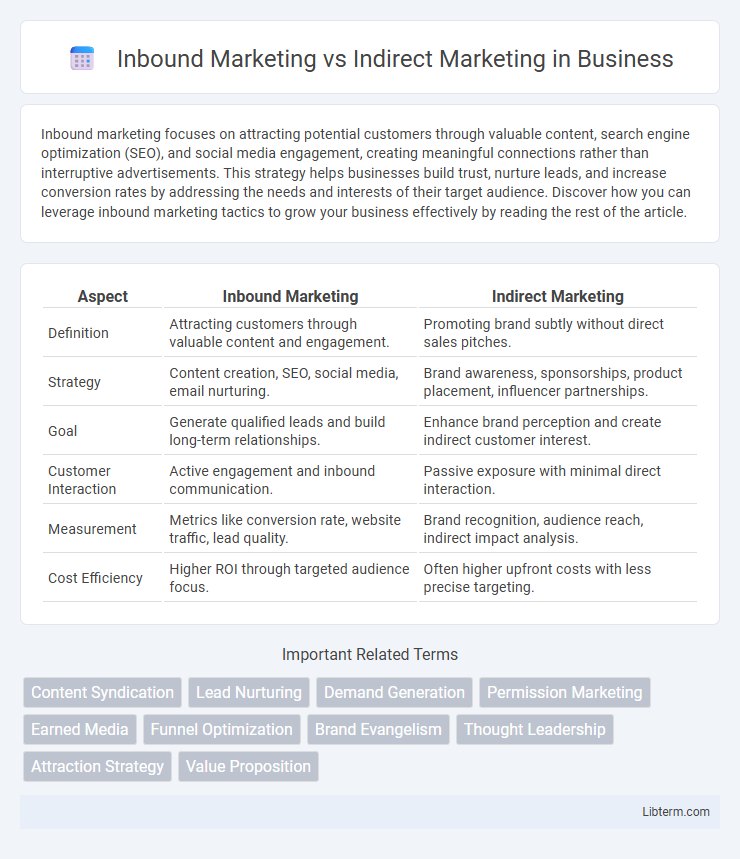Inbound marketing focuses on attracting potential customers through valuable content, search engine optimization (SEO), and social media engagement, creating meaningful connections rather than interruptive advertisements. This strategy helps businesses build trust, nurture leads, and increase conversion rates by addressing the needs and interests of their target audience. Discover how you can leverage inbound marketing tactics to grow your business effectively by reading the rest of the article.
Table of Comparison
| Aspect | Inbound Marketing | Indirect Marketing |
|---|---|---|
| Definition | Attracting customers through valuable content and engagement. | Promoting brand subtly without direct sales pitches. |
| Strategy | Content creation, SEO, social media, email nurturing. | Brand awareness, sponsorships, product placement, influencer partnerships. |
| Goal | Generate qualified leads and build long-term relationships. | Enhance brand perception and create indirect customer interest. |
| Customer Interaction | Active engagement and inbound communication. | Passive exposure with minimal direct interaction. |
| Measurement | Metrics like conversion rate, website traffic, lead quality. | Brand recognition, audience reach, indirect impact analysis. |
| Cost Efficiency | Higher ROI through targeted audience focus. | Often higher upfront costs with less precise targeting. |
Definition of Inbound Marketing
Inbound marketing is a customer-centric strategy that attracts prospects by creating valuable content and experiences tailored to their needs, leveraging SEO, social media, and content marketing. Unlike indirect marketing, which promotes brand awareness through subtle, non-direct promotional efforts such as sponsorships and product placements, inbound marketing focuses on generating leads by engaging potential customers with relevant information. This approach builds trust and long-term relationships by addressing pain points and providing solutions before pushing sales messages.
Understanding Indirect Marketing
Indirect marketing leverages subtle strategies like content marketing, social media engagement, and brand partnerships to build long-term customer relationships without overtly promoting products. Unlike inbound marketing, which attracts prospects through valuable content and search optimization, indirect marketing emphasizes brand awareness and credibility through indirect touchpoints. This approach nurtures trust and influence by creating a positive brand presence that encourages customer loyalty over time.
Key Differences Between Inbound and Indirect Marketing
Inbound marketing centers on attracting customers through valuable content and personalized engagement, leveraging SEO, social media, and lead nurturing to pull prospects into the sales funnel. Indirect marketing uses subtle promotional techniques, such as brand awareness campaigns and third-party endorsements, to influence customer perceptions without direct sales messaging. The key difference lies in inbound marketing's focus on active customer engagement and content-driven interaction versus indirect marketing's reliance on indirect brand influence and passive customer attraction.
Core Strategies of Inbound Marketing
Core strategies of Inbound Marketing include content creation, SEO optimization, and social media engagement that attract potential customers by providing valuable and relevant information. This approach relies on drawing in leads through educational blog posts, videos, and personalized email campaigns rather than interruptive advertising. In contrast to Indirect Marketing, which builds brand awareness subtly through brand associations and sponsorships, Inbound Marketing actively cultivates customer relationships by addressing their needs and fostering trust.
Tactics Used in Indirect Marketing
Indirect marketing tactics primarily include content marketing, social media engagement, influencer partnerships, and event sponsorships that subtly promote brand awareness without direct sales pitches. These strategies emphasize building long-term relationships and trust with potential customers by providing valuable information and experiences rather than immediate product promotion. Unlike inbound marketing's focus on attracting leads through search engine optimization and lead magnets, indirect marketing leverages indirect touchpoints to nurture brand perception and customer loyalty.
Pros and Cons of Inbound Marketing
Inbound marketing excels at attracting qualified leads through content creation, SEO, and social media engagement, resulting in higher conversion rates and cost efficiency compared to traditional methods. However, it requires significant time investment and continuous content production to maintain effectiveness and build trust over the long term. Despite these challenges, inbound marketing fosters stronger customer relationships and brand loyalty by providing valuable, relevant information tailored to audience needs.
Advantages and Limitations of Indirect Marketing
Indirect marketing leverages third-party channels and influencers to subtly promote products, creating brand awareness without overt sales pitches, which enhances consumer trust and broadens market reach. Its advantages include cost-effectiveness, scalability, and the ability to tap into established audiences, but it faces limitations such as less control over messaging, slower customer conversion rates, and difficulty in measuring direct ROI compared to inbound marketing strategies. Businesses must weigh these factors when integrating indirect marketing into comprehensive digital marketing campaigns for optimal results.
Measuring Success: Inbound vs Indirect Metrics
Measuring success in inbound marketing relies heavily on metrics such as website traffic, lead conversion rates, and content engagement, which reflect the effectiveness of attracting and nurturing prospects through valuable content. Indirect marketing success is often assessed through brand awareness indicators, customer sentiment analysis, and long-term sales growth, capturing the impact of subtle brand presence rather than immediate conversions. Analytics tools like Google Analytics and CRM platforms help track inbound metrics, while indirect marketing effectiveness is frequently gauged through market surveys and social listening platforms.
Choosing the Right Approach for Your Business
Choosing between inbound marketing and indirect marketing hinges on your business goals, target audience, and budget. Inbound marketing focuses on attracting customers through content creation, SEO, and social media engagement, ideal for businesses seeking long-term relationships and organic growth. Indirect marketing relies on partnerships, sponsorships, and brand positioning to build awareness subtly, suitable for companies aiming to enhance trust and market presence without overt selling.
Future Trends in Inbound and Indirect Marketing
Future trends in inbound marketing emphasize AI-driven personalization and automation, enhancing customer engagement through tailored content and seamless multi-channel experiences. Indirect marketing is evolving with increased reliance on influencer partnerships and brand storytelling to subtly build trust and brand loyalty over time. Both strategies will integrate data analytics and customer insights to optimize campaign effectiveness and adapt to shifting consumer behaviors.
Inbound Marketing Infographic

 libterm.com
libterm.com